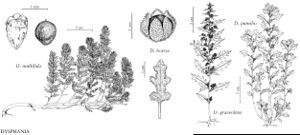Dysphania pumilio
Ukrayins’k. Bot. Zhurn., n. s. 59: 382. 2002.
Stems prostrate to suberect, much-branched to ± simple, 0.1–4.5 dm, pilose with segmented (uniseriate) hairs and sessile or stipitate glandular hairs. Leaves malodorous; petiole 0.3–1.5 cm; blade narrowly to broadly elliptic to ovate, 0.5–2.7 × 0.3–1.5 cm, somewhat reduced in inflorescence, base cuneate, apex obtuse, glandular-pilose. Inflorescences lateral cymes or glomerules; glomerules subglobose, 1.2–2.5 mm diam.; bracts leaflike, 3–4.5 mm, elliptic, margins crenate-dentate, apex obtuse. Flowers: perianth segments 5, distinct nearly to base, distinct portions narrowly elliptic to narrowly oblong, 0.6–0.7 × 0.2–0.3 mm, apex acute, normally rounded abaxially, usually glandular-pilosulose, becoming crustaceous and white in fruit; stamens absent or 1; stigmas 2. Achenes ovoid; pericarp adherent, membranaceous, slightly rugose. Seeds reddish brown, ovoid, 0.5–0.7 × 0.5–0.6 mm, margins keeled or rounded; seed coat smooth.
Phenology: Fruiting late summer–fall.
Habitat: Waste areas on rocky, sandy, or gravelly soils, sidewalks, rare in moist soils in forests
Elevation: 0-1200 m
Distribution

Introduced; Ark., Calif., Conn., D.C., Fla., Ga., Ill., Kans., Ky., La., Mass., Mo., Nev., N.J., N.Y., Ohio, Okla., Oreg., Pa., R.I., S.C., Tenn., Tex., Va., Wash., Wis., Australia, introduced in subtropical and warm-temperate regions.
Discussion
This species has gone under the misapplied name Chenopodium carinatum R. Brown (now 9. Dysphania carinata).
Selected References
None.
